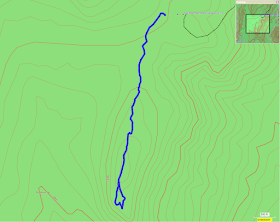 |
| View from overlook/campsite |
The Trail
This is a strenuous 12 mile trail with a 4731 foot elevation change. There is a decent mix of sun and shade along the way as the trail heads in and out of groups of trees and open areas. When doing this trail, we started from Rock Canyon and ended in South Fork Canyon. The first part of the trail up Rock Canyon looks like a road. This splits into a couple different roads and trails. It does not matter which one you take; they all end up in the same place. There are also a number of good rock climbing spots in this area. Continue to follow the main trail straight up Rock Canyon without veering off onto one of the side trails, such as the one heading up to
Squaw Peak about 1.7 miles up the trail. Eventually, you will end up at a campground about 3.1 miles from the Rock Canyon Trailhead. There are restrooms available here too. Go through the campground and find the trail labeled 006 on the other side. This trail continues east across a dirt road and beyond. There are some beautiful meadows and amazing views of the surrounding mountains as you continue up toward the saddle. Many different wildflowers grow here as well, adding a lot of color to the meadows and slopes.
 |
| Looking up the mouth of Rock Canyon |
The trail splits shortly before the saddle (about 6.6 miles from the Rock Canyon Trailhead and about 5.4 miles from the Big Springs Trailhead). Stay left here to take the trail toward Big Spring. The other trail follows Shingle Mill Canyon and eventually connects with Shingle Mill Canyon Road, which then connects with South Fork Canyon Road as well, but it is a bit longer route.
 |
| Looking up toward Shingle Mill Peak |
After crossing the saddle, hikers will start a steep slippery decent toward Big Springs. The trail here is covered with lose gravel, rocks, and dirt, and it can be a bit treacherous if you are not careful. Eventually, it becomes more stable as the ground becomes more solid. The lower portions of this trail are very popular for horseback riding. The trail splits up a bit as you draw closer to the park. There are a couple different trails and a dirt road. They are all similar in length and will lead you back to the parking area.
It would probably be easier to do this trail starting from South Fork Canyon and ending in Rock Canyon.
Most of this trail is open to dogs and livestock. However, horses are not allowed at the beginning portion of the trail up Rock Canyon. To get to other areas behind Rock Canyon by horseback, I recommend going up Slate or Slide Canyon.
 |
| Topographical Map |
 |
| Topographical Map Detail of Rock Canyon Area |
In the maps above, the blue flag marks the turn off from Rock Canyon to hike Squaw Peak. The blue dot marks a drinking fountain. There is another drinking fountain before this point as well. The green dot marks an over look and a backpacking campsite. The restroom symbol marks the restrooms at the campgrounds at that point. The green flag marks a trail split, and the trail shown continues toward Big Springs. Hikers can eventually reach the same point by taking the other trail, the Shingle Mill Trail, which is a bit longer and ends further up South Fork Canyon. The red flag marks Cascade Saddle, and the green tent marks another large camp area.
 |
| Trail in Google Earth |
 |
Graph of Elevation
|
 |
| Looking down toward Provo from near the saddle |
 |
| Near the saddle looking at Shingle Mill and Freedom Peaks |
 |
| View looking toward Mt. Timpanogos & South Fork Canyon from Cascade Saddle |
 |
| River along Rock Canyon |
Directions
This trail is located in Utah County. To get to the trail head at Rock Canyon, take exit 269 off I-15 for University Parkway. Head east along University Parkway to 900 East. Turn left at 900 East, go to Temple View Drive, and turn right. Then turn right at 2300 North. When the road turns off to the right, stay straight to enter the parking area for the Rock Canyon Trail.
To get to the trail head up South Fork Canyon, take exit 272 off of I-15 for 800 North in Orem. Head east along 800 North until the road splits. Take the left fork to head up Provo Canyon. Continue up the canyon for about 5.8 miles, and then turn right onto South Fork Road (toward Vivian park). Drive up South Fork Road for about 3.3 miles, then turn right onto Spring Hollow Road. You will find yourself in a park. If you drive up to the end of this road past the restrooms, there will be a large parking area. The trail starts along the west side of this lot. Please note the location for this trail shows the trail head at South Fork Canyon.
 |
| Looking down at Squaw Peak |

















































